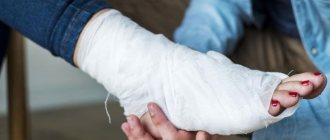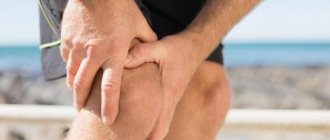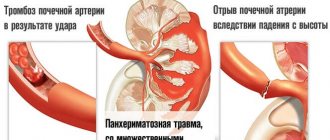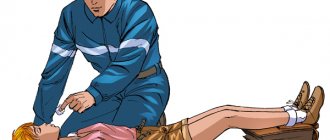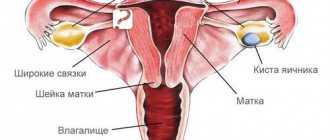An ankle sprain is a nasty sports injury in which a ligament is partially or completely torn. Such injuries are most often the result of traumatic effects on the ligamentous apparatus of the ankle joint. The damage may involve several ligaments at once, not just one.
The ArthroMedCenter Joint and Spine Clinic has been treating sports injuries for many years, using an innovative technique - MBST therapy - to restore damaged tissue.
The increased degree of injury to the ankle ligaments is due to the fact that the ankle joint is an extremely mobile joint, with a large degree of freedom of movement. The lower leg is constantly subjected to a load equal to the body weight (and when performing physical exercises, the weight increases even more). This injury is very common among athletes: if during training a person did not follow safety precautions and exercise technique, then he can damage the ligaments. However, this injury often occurs in everyday life, for example, due to simple carelessness: you can fall unsuccessfully.
MBST therapy
The ArthroMedCenter clinic offers a progressive treatment method aimed at restoring tissue after an ankle sprain - MBST therapy. MBST is a therapeutic magnetic resonance therapy used in clinical practice in the mode of several programs encoded on a chip card. Programs are designed to treat injuries and illnesses.
For ankle sprains, the course of treatment is 7 or 10 procedures, 1 hour per day. At this time, the patient lies on the device and “receives” the incoming energy without feeling discomfort.
There are 3-day programs prescribed to athletes after intense competitions and training, as well as to prevent damage to cartilage tissue. Magnetic resonance therapy uses energy that is produced by hydrogen atoms. In some way, sports injuries are treated with bioenergy, and its use is not associated with consequences for the body and the risk of complications. The procedure can be repeated.
Complications and prognosis
No injury goes away without a trace, especially when it comes to damage to ligaments, because the latter recover very slowly. Even a minor injury is fraught with serious complications, but after more severe injuries they occur even more often. These include:
- sprained ankle;
- flat feet;
- arthritis and arthrosis;
- tendonitis - inflammation of the tendons.
After mild to moderate sprains, the prognosis is generally favorable. In particularly severe cases, there is a high probability of an unfavorable prognosis, such as the development of lameness.
How does MBST work?
The principle of operation of this therapeutic method is based on the fact that tissue metabolism is regulated by electric and magnetic fields. And if in a healthy organ or system the processes of regeneration, that is, renewal, occur independently, then in case of dysfunction they require impulse influence from the outside. In MBST therapy, magnetic resonance is used as such an impulse, which sends signals to diseased tissues that reproduce signals from a healthy body system. Normalized metabolism allows you to resume the regeneration process in the cells of cartilage, bone tissue, tendons, etc. This allows you to eliminate the cause of disorders of the musculoskeletal system, and not only relieve the patient from the unpleasant symptoms of the disease.
Based on research, physicists and engineers were able to design equipment for the non-surgical treatment of sports injuries and diseases of the musculoskeletal system. Scientific and clinical studies have fully confirmed the restoration of cartilage using this method, and the method itself has been patented under the name MBST. This is the first and so far only therapeutic method that uses magnetic resonance for chronic and osteoarticular diseases. It has been officially approved for the treatment of osteoarthritis and osteoporosis and has been used for more than 15 years in Germany, Switzerland, Austria, Israel, Spain, Great Britain, Italy, Croatia, Romania, Slovenia, Czech Republic, and more recently in Turkey, Malaysia, the Philippines , in the Netherlands, in China and in India.
How to strengthen your ankle?
If your legs hurt
Discomfort in the legs can be a symptom of various diseases that require urgent medical attention. Find out what leg pain means.
- While sitting on a chair, try writing the letters of the alphabet in the air with your toes. Repeat the same with the other leg.
- At least 20 times a day, while walking, focus on how the muscles and ligaments of your foot and ankle move. Try to keep every step controlled.
- Use your bare toes to grab various objects on the floor. Start with a rolled towel, gradually pulling it towards you. Pick up plastic cups, matchboxes, large buttons and coins.
- Gently press the sole of your foot against a stationary object in the four directions of ankle movement: up, down, in, out.
What other injuries can be treated with MBST?
Indications for using the MBST method:
- Achilles tendon injuries.
- Tendon injuries, partial tear of the medial collateral ligament of the knee, or tendinitis due to patellar tendon syndrome.
- Hip (muscle injuries).
- Knee joints (jumper's knee, cartilage and meniscus damage).
- As a conservative addition to cartilage wear/degradation and in cases after arthroscopy.
- Bone contusion/Bone swelling, osteochondritis dissecans or bone necrosis, pseudarthrosis, fractures and stress fractures.
How to properly apply a bandage for a sprained ankle
Before applying the bandage, it is necessary to ensure the correct position of the foot. In case of ligament damage:
- Calcaneofibular, anterior and posterior talofibular - the plantar side is retracted outward.
- Deltoid - the plantar side is retracted inward.
- Intertibiofibular – the foot is slightly bent.
The limb is bandaged from the narrow part to the wide part, in the form of a figure eight: first on the ankle, and then on to the foot. Each layer is wound without wrinkles or folds and should overlap the previous one. It is necessary to control the degree of tension so as not to compress the blood vessels, and at the same time ensure reliable fixation of the joint. The procedure ends on the ankle, and the bandage is fixed on its outer side.
© Andrey Popov — stock.adobe.com
Why does ankle sprain occur?
The ligamentous apparatus of the ankle can withstand quite serious loads, so in order to injure it, it is necessary to make an effort. An injury occurs at a time when the load is distributed incorrectly, that is, it is distributed not over several ligaments, but into one. As a result of overstrain, it stretches and breaks. Increased stress on the ankle ligaments can occur:
- when tucking the outer edge of the foot, the entire body weight will be distributed precisely over this area. In this case, injury occurs due to excessive supination of the leg;
- with maximum extension of the leg (while fixing the foot). In this case, injury occurs to the anterior talofibular and interfibular ligaments;
- in situations where the body weight is transferred to the forefoot (when it is fixed), and the lower leg is bent. In this case we are talking about an injury to the Achilles tendon.
- when the foot rotates (externally or internally), the foot is fixed. Ligaments are injured depending on the direction of the applied load - these can be internal or external ligaments, tendons of the peroneus brevis and longus muscles, etc. If we are talking about excessive internal rotation, the tendons of the tibialis posterior muscle can be damaged.
Types and degrees of ankle sprains
There are several types of injuries:
- turning the foot inward (inversion);
- turning the stoop outward (eversion);
- sprain of the upper ankle.
An ankle sprain can have several degrees of severity, which are distinguished based on the amount of damage to the ankle ligaments: The first degree is minor trauma. This type of injury is characterized by tearing of the fibers, but more than half of them remain intact. Treatment for such an injury does not last long, as does the rehabilitation period after it.
The second degree is a severe ankle sprain. Treatment in this case is more labor-intensive and lengthy than with the first degree of sprain. The second degree of severity is characterized by rupture of a significant part of the collagen fibers (about half). You can observe swelling of the injured area, as well as displacement of the articular elements.
Third degree - complete rupture of the ankle ligaments. There is pathological mobility in the joint, very pronounced swelling and pain in the injured area. It is important that immediately after receiving such an injury, first aid for an ankle sprain is provided, and then the person is taken to the clinic. This degree of severity is characterized by longer and more serious treatment. The rehabilitation process in this case also slows down.
Three degrees of stretch
To know how to treat a sprained ligament around the ankle, the doctor, based on the clinical picture and additional examination, determines the severity of the injury.
There are 3 degrees of stretching:
- A mild sprain occurs when there are microscopic tears in the fibers of the ligaments. It is characterized by mild symptoms - mild pain and slight swelling at the site of injury. Patients may also experience mild limitation of mobility in the ankle. However, in most cases they can walk and even run. Improvement in this type of sprain occurs quickly. Full recovery occurs after 2–4 weeks.
- A moderate sprain occurs when a ligament is partially torn.
In such cases, the symptoms are more pronounced. In most cases, patients experience moderate to severe pain in the ankle joint, swelling and bleeding at the site of injury. A person with a grade 2 sprain has difficulty walking. Full recovery may take 4 to 8 weeks. - A severe sprain occurs when a ligament is completely or almost completely torn.
Immediately after the injury, the patient experiences severe ankle pain, swelling, and bleeding. The affected joint becomes unstable and the person cannot step on the foot. In such cases, recovery may take more than 3 months.
Sprain grades: from healthy to complete rupture
First aid for sprains
When spraining the ankle joint, timely first aid greatly influences the restoration of the tissues of the injured ligament and determines the time for complete restoration of joint function.
- First of all, apply ice wrapped in a towel (to prevent frostbite) to the injured ankle for 10-15 minutes, repeat the procedure after 15 minutes. Such manipulations will help not only relieve pain, but also stop the spread of edema (under the influence of cold, blood vessels reflexively narrow).
- The injured ankle must be kept at rest, and until an accurate diagnosis is made, you should not lean on the foot. Using a homemade or transport splint, you need to secure your leg. Fixation of the area should be maintained until examined by a traumatologist or surgeon.
- Place a bolster under your leg to give it an elevated position.
- Introduce an analgesic into the body (orally or by injection) if possible.
First aid
Since no one is immune from injury, you need to know what to do if you sprain your ankle.
As first aid for a sprained ankle, you should:
- remove your feet from shoes;
- ask the victim to take a comfortable position;
- elevate your leg to reduce swelling;
- apply a cold compress to the sore area for two to three hours to relieve swelling, taking half-hour breaks to avoid the risk of hypothermia;
- provide fixation of the damaged area by applying a bandage;
- To relieve pain, you can give the victim an over-the-counter pain reliever. Anti-inflammatory drugs and ointments can only be taken as prescribed by a doctor.
Symptoms of an ankle sprain
Symptoms of ankle sprains appear depending on the extent of the injury and the number of tendons involved in the injury mechanism. A complete rupture of the ankle ligaments is only caused by a sprain. This condition is characterized by excessive mobility in all projections of the joint. The main symptoms of an ankle sprain are:
- severe pain that occurs at the time of injury (fall, blow, etc.);
- swelling around the injured area (around the medial or lateral malleolus);
- bruising;
- extensive hematomas;
- local increase in temperature (in the injured area).
When trying to make a movement, a person also continues to experience pain.
Repeated ankle sprains lead to complete rupture of the tendon. More long-term and complex as well as longer rehabilitation will be required. That is why specialists at the ArthroMedCenter clinic recommend that you consult a doctor at the first sign of a sprain. To exclude repeated injuries, as well as the development of any other pathologies, it is worth carrying out a full course of treatment, including rehabilitation.
Physiotherapy
If the ankle is sprained, UHF therapy is prescribed. Alternating currents dilate blood vessels and accelerate regenerative processes.
- The effect of ultrasound is comparable to micromassage. The technology relieves inflammatory reactions and reduces the sensitivity of nerve receptors in the affected area.
- Paraffin applications have an analgesic and stimulating effect.
- Alternating different-frequency currents in diadynamic therapy is used for pain blockade.
- Hardware massage enhances the effect of procedures, relieves muscle spasms, and improves nutrition of soft tissue structures.
Diagnosis of ankle sprains
The diagnosis of sprain is made based on the existing symptoms, as well as data from such studies as:
- magnetic resonance imaging (MRI);
- ultrasonic examination (ultrasound) of the joint;
- arthroscopy.
X-rays are not used to make a diagnosis, since the ligaments are a soft tissue formation, i.e. they are not visible on an X-ray. However, the patient may be referred for an x-ray to rule out a fracture. The symptoms of fractures and sprains are very similar, in addition, some symptoms can be combined with each other.
Diagnostics
During the initial examination, the severity of the injury is first determined by palpation and stress tests, which are carried out to exclude x-ray examination for the presence of a fracture. If the cause cannot be determined by these methods, then X-rays of the ankle are taken in three planes. Also, the feasibility of such a study is determined using the Ottawa rules for examining the ankle: if the victim cannot support body weight while taking four steps, then further clarification of the diagnosis is required, and the probability of a fracture is high (95-98%).
To clarify the condition of ligaments, soft tissues and identify hidden hematomas, magnetic resonance or computed tomography is prescribed.
Preventing ankle sprains
Ankle sprains can occur in anyone if they are not careful during exercise and outdoor activities. If you want to play sports, do it in suitable shoes and clothing. Walk carefully in high-heeled shoes, avoid potholes and potholes, and watch your step when walking somewhere. Try to fight excess weight, as obesity of any degree puts excessive stress on the joints. Lead an active lifestyle, play sports, eat well. Moderate physical activity strengthens.
Causes of sprains
Sprains occur when walking in heels, when slipping, in beginning athletes who have not yet mastered the correct training technique.
The likelihood of sprains is higher if the following factors are present:
- uncomfortable shoes;
- too high or low instep;
- sedentary or hyperactive lifestyle;
- arthritis, arthrosis, history of diabetes mellitus;
- overweight.
How to treat a sprained ankle?
Physiotherapy
- The use of ultrasound - this procedure not only improves microcirculation of the damaged area, but also accelerates the process of lymph outflow. After this procedure, the ointments are absorbed much better, and the drug accumulates in the tissues.
- UHF is used to reduce local inflammation and accelerate reparative processes in tissues. Vasodilation helps improve the trophism of the affected area.
- Paraffin therapy is one of the main activities. The main effect of this therapy is to reduce pain and eliminate inflammatory processes. Can be used in any period after injury.
- Magnetic therapy – promotes the outflow of blood and lymph, enhances the absorption of local medications, and relieves inflammation.
- Electrophoresis with non-steroidal anti-inflammatory drugs or novocaine. Pain relief is achieved by dilating blood vessels.
Gymnastics
Any gymnastic exercises to strengthen the ankle joint can only be performed in the long term (about 1-3 months, depending on the degree of injury).
- Development of motor skills of the toes.
- Rolling a bottle with your foot.
- Walking on your heels.
- Running on small pebbles or sand.
- Circular rotations of the foot.
- Extension and flexion of the leg at the ankle joint.
- Walking on the outside and inside of the foot.
- Walk on your toes for a few minutes every day.
Treatment
For a minor sprain of the ankle or ankle (grade 1 or 2), a tight bandage or kinesio taping combined with partial or complete weight restriction for one to two weeks is sufficient. For the first few days, cold compresses and analgesics are used to relieve pain and reduce swelling. Then anesthetic and anti-inflammatory ointments are applied to the injury site.
Nise gel has a good local anesthetic effect.
On the second or third day, physiotherapy procedures (UHF, magnetic therapy, laser treatment) and various warming procedures (paraffin compresses or isokerite) are prescribed. If it is possible to step on your foot, you are allowed to start walking and perform simple exercises: wiggling your toes, turning and rotating your foot.
In more severe cases, hospitalization and surgical intervention may be required, after which long-term conservative treatment is carried out (2-3 months) and the lower leg is fixed with a plaster splint until the ligaments are completely healed.
Additional information on recovery
Second and third degree sprains require increased caution. There should be absolutely no stress on the ankle, so getting to the rehabilitation point is quite difficult. The situation becomes more complicated if the injured person is alone. You should not take any independent steps. You need to contact someone and call for help, but under no circumstances stand on your injured leg.
Cold liquids or objects you have with you, if any, are applied to the leg. People involved in sports should only have a freezing spray and an elastic bandage with them. If they manage to provide first aid to themselves through independent efforts, they do nothing further. The leg is placed on an elevation and awaits qualified assistance.
On the second or fourth day, when the swelling disappears, begin the exercises. The occurrence of pain requires immediate cessation of the warm-up. Surgeons and traumatologists recommend starting to do exercises as early as possible, but increasing the load gradually.
Warm-up is necessary as a preventive measure to ligament fusion in one position, which impairs the mobility of the ankle, and can also provoke atrophy of muscle tissue due to prolonged absence of any load. This is typical for fractures, since they require long-term rehabilitation.
A speedy recovery is facilitated by the use of ointments with analgesics and anesthetics, as well as anti-inflammatory drugs. The main thing is to pay attention to the injury, undergo proper rehabilitation, and healing will take place quickly and without complications.
What reasons lead to stretching?
The root cause of an ankle injury is the foot being in an incorrect position when it turns inward. There are other factors that lead to stretching:
- supination or high arch of the foot;
- underdeveloped foot and peroneal muscles, which often occurs against the background of intense training for other muscle groups, when the main focus is on the bench press and training on machines to the detriment of the lower extremities;
- contrary to the previous point, ligaments can weaken as a result of minimal human activity, which leads to their softening when the bones are poorly held together;
- size disproportion and disproportionate bone growth;
- disruption of the neuromuscular junction, which leads to involuntary ankle twisting;
- Having suffered minor sprains and sprains in the past, which makes the ankle unstable and weak.
Often, ligaments are subject to constant stretching in people who take steps incorrectly - turning or turning the foot inward or outward at a large degree. This type of walking habit weakens the ankle joint, and the ligaments inevitably become injured in the long run.
What is important for ankle ligament rehabilitation?
